In World War I, bacterial infections ravaged armies. Cholera left soldiers dead within days, and gas gangrene turned minor wounds into certain fatalities. At the outbreak of war German medical student Gerhard Domagk interrupted his studies to join the army. As an aide in Ukraine military hospitals, he witnessed the helplessness of medicine against lethal bacterial infections.
Back in the laboratory Domagk fought successfully against that helplessness. This year marks the 75th anniversary of Domagk’s 1935 landmark paper introducing Prontosil Rubrum, the first drug to cure bacterial infections and the first of many sulfa drugs.
After serving in the Sanitary Service during the war, Domagk returned to medical school and later became the director of the Institute of Experimental Pathology at I.G. Farbenindustrie. Here Domagk led the research to develop treatments for common bacterial infections. After a number of unsuccessful attempts I.G. Farbenindustrie chemists repeated an old trick used to make dyes bind better to wool. They introduced sulfonamide function into azo dyes and found a promising chemical combination. The new sulfonamide successfully cured mice infected with an extremely virulent form of Streptococcus pyogenes. On Christmas Day, 1932, I.G. Farben submitted a patent application for sulfonamide dyes, one of which would be named Prontosil Rubrum.
In 1935 Domagk published a paper detailing the clinical results of treatments with Prontosil. At first, the medical community was skeptical that a drug could be effective against generalized bacterial infections. Later that year, Domagk’s daughter Hildegarde developed severe blood poisoning after falling down stairs and jabbing a sewing needle through her hand. Domagk treated her with the new drug and within a week the fever subsided. In the United States, Prontosil remained an almost unknown drug until it cured Franklin Delano Roosevelt, Jr., son of the 32nd president, of a life threatening strep infection in late 1936.

From 1935 until 1942 doctors used Prontosil almost exclusively to fight bacterial infections. Although Alexander Fleming discovered the Penicillium fungus in 1928, wholesale manufacturing of the drug proved difficult and delayed its use. However, the untroubled use of sulfonamide drugs came to a sudden halt in 1937, when S. E. Massengill Company marketed an “Elixir of Sulfanilamide” in the United States.
Company chemist Harold Watkins dissolved the drug in a 10% solution of diethylene glycol mixed with raspberry flavoring and sweetened with saccharin. Over the next two months 105 people died from liver and kidney damage caused by the solvent. Watkins killed himself after he learned of the lethal effects of the “Elixir.” All the FDA could do was fine Massengill $26,000 for false labeling because no law required toxicity testing of drugs before marketing. In response Congress passed the Federal Food, Drug, and Cosmetic Act to regulate drug safety.
In 1939 Domagk won the Nobel Prize in Physiology or Medicine. Fearing retaliation from the Nazi regime, Domagk responded that he was honored to be chosen but would have to wait for government approval to accept the award. Hitler had earlier decreed it illegal for Germans to accept a Nobel Prize after the committee offended Hitler by awarding the 1935 Peace Prize to a German anti-Nazi. Despite Domagk’s actions, the Gestapo imprisoned him for several days and forced him to sign a document refusing the prize.
In 1947, Domagk traveled to Stockholm to finally accept his award. In his prescient speech he warned of the risks of antibiotic resistance. He ended the lecture with his research philosophy, undoubtedly influenced by his early days in wartime hospitals: “I consider it my first duty in the development of chemotherapy to cure those diseases which have hitherto been incurable, so that in the first place those patients are helped who can be helped in no other way.”




